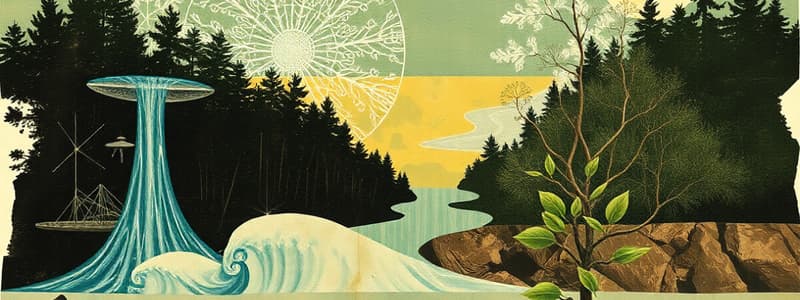Podcast
Questions and Answers
What is the primary role of transpiration in the water cycle?
What is the primary role of transpiration in the water cycle?
- To absorb water from the atmosphere
- To evaporate water absorbed by plants (correct)
- To create energy through photosynthesis
- To cool down the surrounding environment
Which structures in plants are responsible for the process of transpiration?
Which structures in plants are responsible for the process of transpiration?
- Leaves
- Guard cells
- Roots
- Stomata (correct)
What percentage of atmospheric water is contributed by transpiration?
What percentage of atmospheric water is contributed by transpiration?
- 10% (correct)
- 50%
- 90%
- 25%
How does evaporation differ from transpiration?
How does evaporation differ from transpiration?
What role does the sun play in the process of evaporation?
What role does the sun play in the process of evaporation?
In what way do animals contribute to the water cycle?
In what way do animals contribute to the water cycle?
What is one effect of warm and dry conditions on the evaporation process?
What is one effect of warm and dry conditions on the evaporation process?
What is the first process in the water cycle that is influenced by the heat from the sun?
What is the first process in the water cycle that is influenced by the heat from the sun?
What forms when water vapor cools and changes back into liquid water in the atmosphere?
What forms when water vapor cools and changes back into liquid water in the atmosphere?
Which of the following is NOT a process involved in the water cycle?
Which of the following is NOT a process involved in the water cycle?
In what form can precipitation return to Earth?
In what form can precipitation return to Earth?
What happens to water vapor as it rises in the atmosphere?
What happens to water vapor as it rises in the atmosphere?
What is the term for the process where water is absorbed into the soil?
What is the term for the process where water is absorbed into the soil?
Which statement about the water cycle is true?
Which statement about the water cycle is true?
What typically happens to water that does not become groundwater after precipitation?
What typically happens to water that does not become groundwater after precipitation?
Flashcards
Water Cycle
Water Cycle
The continuous movement of water on, above, and below the surface of the Earth.
Evaporation
Evaporation
The process where liquid water changes into water vapor (a gas).
Condensation
Condensation
The process where water vapor changes into liquid water or ice.
Precipitation
Precipitation
Signup and view all the flashcards
Transpiration
Transpiration
Signup and view all the flashcards
Atmosphere
Atmosphere
Signup and view all the flashcards
Groundwater
Groundwater
Signup and view all the flashcards
Runoff
Runoff
Signup and view all the flashcards
What is transpiration in the water cycle?
What is transpiration in the water cycle?
Signup and view all the flashcards
How do plants contribute to the water cycle?
How do plants contribute to the water cycle?
Signup and view all the flashcards
Stomata
Stomata
Signup and view all the flashcards
How does transpiration help plants?
How does transpiration help plants?
Signup and view all the flashcards
What is the main difference between transpiration and evaporation?
What is the main difference between transpiration and evaporation?
Signup and view all the flashcards
How do animals contribute to the water cycle?
How do animals contribute to the water cycle?
Signup and view all the flashcards
Study Notes
Plant Contribution to the Water Cycle
-
Transpiration: Plants release water vapor into the atmosphere through tiny openings called stomata on their leaves. This process contributes about 10% of atmospheric water.
-
Mechanism: Plants absorb water from the soil through their roots. Some of this water travels to the leaves and evaporates through the stomata. This evaporation creates a negative pressure, drawing more water from the roots via osmosis.
-
Stomata: These microscopic pores on the underside of leaves control water release and also allow CO2 uptake for photosynthesis.
-
Importance to plants: Transpiration is vital for nutrient and water uptake from the soil. The process draws water up through the plant from the roots to the leaves.
Water Cycle Overview
-
Hydrologic Cycle: Water continuously circulates through the atmosphere and Earth's surface.
-
Processes: The cycle includes evaporation, condensation, precipitation, and transpiration (and evapotranspiration).
-
Evaporation: Liquid water turns to water vapor due to heat from the sun, even without direct sunlight. Evaporation is faster in warmer, wetter areas.
-
Condensation: Water vapor cools and transforms into liquid or solid form (clouds).
-
Precipitation: Water falls from clouds as rain, snow, sleet, and hail.
-
Runoff/Infiltration: Water moves on the surface or seeps into the ground.
-
Groundwater: Water that has seeped into the ground.
-
Evapotranspiration: A combined process of evaporation and transpiration, describing the movement of liquid water from the surface as a gas.
-
Plant Role: Plants play a significant role in evapotranspiration.
Comparison of Evaporation and Transpiration
-
Similarities: Both processes convert liquid water to water vapor.
-
Differences: Evaporation happens any time liquid water is exposed to warm air, while transpiration is specific to plants; they absorb water from the soil and release it through stomata.
Studying That Suits You
Use AI to generate personalized quizzes and flashcards to suit your learning preferences.




